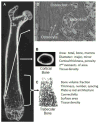Genetics of aging bone
- PMID: 27272104
- PMCID: PMC4948189
- DOI: 10.1007/s00335-016-9650-y
Genetics of aging bone
Abstract
With aging, the skeleton experiences a number of changes, which include reductions in mass and changes in matrix composition, leading to fragility and ultimately an increase of fracture risk. A number of aspects of bone physiology are controlled by genetic factors, including peak bone mass, bone shape, and composition; however, forward genetic studies in humans have largely concentrated on clinically available measures such as bone mineral density (BMD). Forward genetic studies in rodents have also heavily focused on BMD; however, investigations of direct measures of bone strength, size, and shape have also been conducted. Overwhelmingly, these studies of the genetics of bone strength have identified loci that modulate strength via influencing bone size, and may not impact the matrix material properties of bone. Many of the rodent forward genetic studies lacked sufficient mapping resolution for candidate gene identification; however, newer studies using genetic mapping populations such as Advanced Intercrosses and the Collaborative Cross appear to have overcome this issue and show promise for future studies. The majority of the genetic mapping studies conducted to date have focused on younger animals and thus an understanding of the genetic control of age-related bone loss represents a key gap in knowledge.
Figures





References
-
- von Friesendorff M, McGuigan FE, Besjakov J, Akesson K. Hip fracture in men-survival and subsequent fractures: a cohort study with 22-year follow-up. J Am Geriatr Soc. 2011 May;59(5):806–13. - PubMed
Publication types
MeSH terms
Grants and funding
LinkOut - more resources
Full Text Sources
Other Literature Sources
Medical
Miscellaneous

